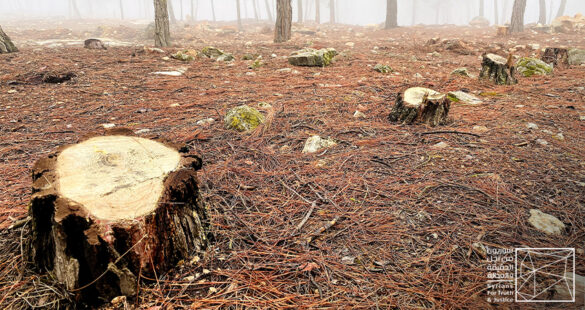Imagine taking a deep breath of crisp forest air, surrounded by the whisper of ancient trees. The tranquility of a nationally protected forest in Eastern Europe feels almost sacred.
But what if this serene picture was interrupted by the sound of chainsaws? The topic of logging in these protected areas sparks a heated debate. Is it truly allowed, or is it just a myth? As someone who values nature and its preservation, understanding the legalities of logging in these forests is crucial.
This article will unravel the truth, helping you grasp the real impact on your beloved natural landscapes. Are you ready to uncover the facts and see how they affect you and the environment? Dive in to explore the nuances and protect what matters most.

Credit: www.yumpu.com
Legal Framework
Logging in protected forests follows strict rules. These rules help keep nature safe. Every country has its own laws for logging. Some countries allow logging in protected areas. Others do not. People must know the rules before logging. Breaking rules can bring big penalties.
Permits And Compliance
A logging permit is often needed. A permit is a paper that allows logging. Without this paper, logging is illegal. Forest rangers check if permits are real. Rangers also check if loggers follow rules. Logging must not hurt the forest. Compliance means following all the rules. Loggers who comply help protect the forest.

Credit: emergency.unhcr.org
Economic Impact
Logging helps local economies grow. It brings much-needed jobs to small towns. With logging, people can earn money. This money helps them buy food and clothes. Logging also supports local shops and markets. With more business, these shops can hire more workers. Logging is a key part of the local economy. It helps many families meet their needs.
Many people find jobs in logging. These jobs include cutting trees and driving trucks. Some work in sawmills and factories. Logging jobs can be hard but pay well. Workers feel proud to support their families. Employment in logging gives hope to many. It helps build strong communities.
Environmental Concerns
Logging can harm many animals and plants. Trees provide homes for birds and insects. Cutting trees removes these homes. Some animals may not find new places to live. This can cause them to die or leave the area. Plants that need shade might not survive in open spaces. Biodiversity keeps forests healthy. Losing species can make forests weaker. Fewer animals and plants can also affect humans. People depend on forests for food and medicine.
Cutting trees increases carbon in the air. Trees absorb carbon dioxide. Fewer trees mean more carbon stays in the atmosphere. This can make the Earth warmer. Warm temperatures can change weather patterns. Some areas may have more floods or droughts. Healthy forests help keep climate stable. Logging can make climate problems worse. Protecting forests is important for the future.
Conservation Strategies
Sustainable logging helps keep forests healthy. Trees are cut in a careful way. This ensures forests can regrow. Workers follow strict rules to protect wildlife. They use special tools that do less harm. This makes sure the forest stays safe.
Reforestation means planting new trees. This helps replace those cut down. It keeps forests strong and alive. Many groups plant trees each year. This supports forest growth and helps nature. Local people join these efforts. They care for trees and watch them grow.
Stakeholder Perspectives
Governments often support loggingrulesreforestation
Local communities play a big role in forest logging. They often depend on forests for their livelihood. Community groups sometimes help in forest management. They ensure logging is done responsibly. Many locals join conservation
Future Outlook
Innovations are helping to make forests better. New tools help track tree growth. They also watch for any damage. Smart drones fly over forests. They take pictures from the sky. This helps people see problems quickly. New apps keep all the data safe. People can use this data to make better decisions. They can plan how to cut trees safely.
Balancing means keeping nature and building both happy. Forests are homes for animals. They also give people wood and jobs. Protecting animals is very important. But people need wood for houses. New rules help balance these needs. Planting new trees after cutting is a good idea. It helps forests grow back. People talk to decide what’s best for everyone.

Credit: news.gallup.com
Frequently Asked Questions
Is Logging Permitted In Eastern Europe’s Protected Forests?
Logging in nationally protected forests in Eastern Europe is generally restricted. However, some exceptions may exist for sustainable management practices. These practices are subject to stringent regulations to ensure ecological balance. Always check local laws and guidelines before considering any logging activity in these regions.
What Laws Regulate Logging In These Forests?
Nationally protected forests in Eastern Europe are governed by strict environmental laws. These laws are designed to preserve biodiversity and prevent deforestation. They often require permits and adherence to sustainable forestry practices. Violations can lead to significant penalties, emphasizing the importance of compliance.
Why Is Logging Controversial In Protected Forests?
Logging in protected forests is controversial due to its environmental impact. It can lead to habitat destruction and biodiversity loss. Critics argue that it undermines conservation efforts. Proponents claim regulated logging can support local economies and forest health. The debate highlights the need for balance between conservation and resource use.
Can Logging Benefit Forest Ecosystems?
Sustainable logging can benefit ecosystems by promoting forest health. It helps remove diseased trees and reduce fire risks. Properly managed logging supports regeneration and biodiversity. However, it must be carefully controlled to avoid detrimental effects on the ecosystem.
Conclusion
The legality of logging in Eastern Europe’s protected forests raises concerns. These forests hold immense ecological value. Logging impacts wildlife and biodiversity. Protecting these areas is crucial for future generations. Laws need review to ensure sustainable practices. Communities must understand the balance between use and conservation.
Educating locals on sustainable methods can help. Forests are vital for clean air and water. Governments must enforce stricter rules. Everyone should play a part in preserving nature. Together, we can protect these precious resources for years to come.
